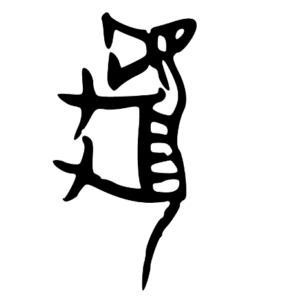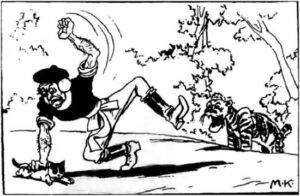‘The historical attitude in China to the tiger is full of contradictions’, observed Cao Zhenfeng, a specialist on Chinese folk tradition. ‘The tiger is both loved and hated; it is a frightening beast as well as a protecting god; it is a sign of danger and a symbol for good luck; it causes people to flee from it but also to chase after it…Never has there been an animal like the tiger that embodies such distinct and discrepant meanings.’ [1]

Oracle bone inscription of the tiger with its wide opening jaw and whipping tail. Source: Chinese Etymology
The current geographic region of China was once home to one of the world’s largest tiger populations. In historical times, there were Siberian or Amur tigers in the northeast, Indochinese tigers in the southwest, and Bengal tigers southeast of Tibet as well as South China tigers found across vast areas south of the Yangtze River. [2] Ancient oracle bone and bronze inscriptions are full of references to the tiger, often shown with its claws out, jaws wide open, and tails swinging. This clear pictorial representation of the animal was eventually replaced by the character for tiger used today, 虎, pronounced hu, which derives from the seal script of the Qin dynasty (221–206 BC).
This modern form is made up of the two symbols 虍, meaning the pattern of the tiger’s skin and 儿, representing a person. Chi Hsu-sheng, a specialist on Chinese etymology, believes that the ‘human’ component was added to the tiger picture because ancient texts often compare people to tigers. Just like how we say, ‘he’s such a tiger!’ today. So the character in fact stands for a ‘human tiger’. In common speech, a tiger is a 老虎 laohu, the added prefix 老 means ‘old’ but is also a form of affectionate address. A teacher is a 老师 laoshi, regardless of age.

Tiger pendant from a Shang tomb (ca. 12th century BC)
Source: Openverse
As a cultural symbol, the tiger stands for power and vigour. Traditionally, it is featured on the clothes and accessories of kings and ministers to signify their authority and courage. Today, some parents in China still dress their children in colourful tiger-head shoes and caps, believed to protect them from disaster and disease. In martial arts, the Fu Jow Pai 虎爪派 or ‘Tiger Claw School’, draws their inspiration for hand combat techniques from the ripping, tearing, pulling, and grasping movements of a tiger’s attack.
On the other hand, the tiger is also a menacing predator, a harmful pest. History books abound with records of ‘tiger troubles’ 虎害 alongside famines and plagues. A famous story from the Book of Rites portrays the tiger under such light, albeit with a political bent:
In passing by the side of mount Tai, Confucius came upon a woman who was wailing bitterly by a grave. The Master sent his disciple Zilu to question her: ‘Your wailing,’ said he, ‘is exactly like that of one who has suffered sorrow after sorrow.’
She replied, ‘It is so. Some time ago, my husband’s father was killed here by a tiger. My husband was also killed by one, and now my son has died in the same way.’
The Master asked, ‘Why do you not leave this place?’
‘There is no oppressive government here,’ answered the woman.
The Master then said to his disciples, ‘Remember this, my children. Oppressive government is more terrible than tigers.’ [3]
Zhang Ji (ca.766–830), a Tang dynasty poet, composed a ballad called ‘Song of the Fierce Tiger’ about a gang of tigers terrorising a local village. Young men from noble families who were sent to deal with them were too frightened to hunt them, only pretending to check for the tigers’ tracks. The song has traditionally been interpreted as a veiled criticism against local thugs and corrupt officials — the gang of tigers — as well as the young men from noble families who are meant to uphold justice, yet quiver in the face of powerful bullies.
Seen in the context of this tradition, it is no wonder that the story of Wu Song slaying a tiger has enjoyed such long-lived mass appeal. This story, set in the twelfth century, is included in the novel Shui Hu Zhuan 水浒传 (sometimes translated as The Water Margin). A man-eating tiger has been attacking travellers on Jingyang Ridge. Arriving at a nearby inn, the traveller Wu Song disregards the warning sign: ‘Three bowls of wine and you can’t cross the ridge’, and knocks back eighteen bowls of wine before setting off. Atop the ridge, he falls asleep, drunk, and awakes startled to find himself face to face with the tiger.
A reader from the Ming dynasty, Jin Shengtan (1608–1661), was struck by the lively and detailed description of Wu Song’s ensuing fight with the tiger. In his notes on this episode, he draws the reader’s attention to the ten different positions in which Wu Song holds his club during the struggle. The club, at a crucial moment, breaks. Jin writes:
We are absolutely stunned and hardly dare to read on. After the club is broken, Wu Song’s extraordinary power of fighting the tiger with his bare hands can be revealed. However, the reader is so frightened that his heart and liver have jumped out of his mouth. [4]
Wu Song eventually kills the tiger, and becomes a hero to the local people for ‘getting rid of the menace’ 为民除害. He is even awarded a thousand strings of cash by the local magistrate. The novel does not say what happened to the body of the tiger. Tigers were, as they are now, treasured commodities. Their pelts are eagerly sought after, and in traditional Chinese medicine, ‘virtues are ascribed to the ashes of the bones, to the fat, skin, claw, liver, blood’. [5] Tiger whiskers are said to be good for toothache and tiger penis, when preserved in liquor, is reputed to enhance a man’s potency. Such added benefits have led to excess hunting of tigers, especially in the past century. Combined with deforestation and loss of habitat the population of tigers has declined drastically. In 2018, it was estimated that fewer than 3,900 tigers existed in the wild. [6]
There’s no longer a need for tiger-slaying heroes like Wu Song. But his story has entered into the popular imagination long before as that of an underdog defeating a much bigger, stronger adversary, like David to Goliath. Mao Zedong, fascinated by the story from boyhood, declared in a speech commemorating the twenty-eighth anniversary of the CCP in 1949:
We must not show the slightest timidity before a wild beast. We must learn from Wu Sung…Either kill the tiger or be eaten by him — one or the other. [7]
Mao also popularised the term ‘Paper Tiger’ 纸老虎, an idiom first used in The Water Margin to denote an empty threat. In 1946, when he was still in Yan’an, Mao used the term to describe hostile imperialist forces such as the US government, a thing that may at first seem as terrifying as a real tiger, but is easily defeated in reality. In recent years, Australia has been on more than one occasion called a ‘Paper Cat’ by the Chinese state media, a more deflating variation of Mao’s original metaphor.
In the jungle of contemporary Chinese politics, the tiger has become synonymous with corrupt senior officials. Mao used the expression ‘hunting big tigers’ 打大老虎 during the PRC’s first anti-corruption campaign, of 1951–52. Half a century later, the expression resurfaced when Xi Jinping launched his major anti-corruption campaign, soon after coming to power in 2012. The slogan ‘strike tigers and flies together’ 老虎苍蝇一起打 (flies being low-level officials, a lesser but more common pest) has since become a trademark of Xi’s ‘strongman’ image. Subsequently, the tiger hunt became a nationwide sport. Just as people in traditional times loved to hear storytellers talk about Wu Song’s conquest of the tiger, many Chinese today enjoy the spectacle of corrupt officials in prison jumpsuits confessing their sins on national television, begging for forgiveness.

Cartoon by Mi Gu 米谷 (1918–86) published during Chiang’s anti-corruption campaign, showing a man wielding his fist at a small cat while a tiger watches nearby, laughing. 1948. Source: Public Domain
The metaphor of tigers and flies so beloved of CCP leaders, has its origin in an earlier anti-graft campaign headed by Chiang Ching-kuo, the son of Mao’s mortal enemy and rival Chiang Kai-shek, whose government the Communist overthrew in 1949. One year earlier, Chiang Ching-kuo arrived in Shanghai to stabilise its economy marred by years of war, corruption, and rampant inflation. The slogan of his campaign was ‘strike the tigers, not the flies’ 只打老虎,不拍苍蝇, making it clear that he was only after the ‘fat cats’ among profiteers and speculators. Unfortunately for Chiang Ching-kuo, the biggest tigers of all happened to be among his own family members and their supporters. He might have ‘talked tiger’ but in the end he could only to go after smaller game, as the cartoon by Mi Gu reproduced here suggests.
While in Shanghai, Chiang Ching-kuo reportedly led a crowd of 5,000 young army veterans singing a song called ‘Two Tigers’ 两只老虎 [8] set to the tune of ‘Frère Jacques’. The same melody had previously served as the Republic of China’s national anthem ‘Song of the National Revolution’. It is unclear when tigers were first written into the lyrics of this song, but Chiang Ching-kuo was reportedly fond of it, singing it on various occasions in Jiangxi province where he served as the commissioner between 1939 and 1945. [9] It is agreed that in the context of Chiang’s anti-corruption campaign, the two tigers refer to profiteers and communists. Yet the lyrics, which are about one tiger missing an ear and another missing a tail, might have originally been poking fun at the isolationist USA, unable to hear cries for help of people around the world, and the Soviet Union, lacking balance and unlikely to survive.
Regardless of its political associations, the song ‘Two Tigers’ went on to become a popular nursery rhyme loved by millions in the Chinese speaking world. Powerful and protective, menacing and harmful, the tiger remains a complex, ambiguous figure in China’s symbolic landscape. And if tigers still symbolically play the villain in the Chinese political agenda, their traditional associations have not been erased, and will continue to live on through countless legends, myths, stories, and songs.
References
[1] Cao Zhenfeng 曹振峰, The Tiger Culture 虎文化, Shanghai: Shanghai jinxiu wenzhang chubanshe, 2009, p.22.
[2] Chris Coggins, The Tiger and the Pangolin: Nature, Culture, and Conservation in China, Honolulu: University of Hawai’i Press, 2003, p.53.
[3] ‘Tan Gong II’ 檀弓下, The Book of Rites 禮記, translation slightly modified based on James Legge’s The Sacred Books of China: the Li Ki, online at: https://ctext.org/liji/tan-gong-ii
[4] Translated by John C. Wang, Chin Sheng-T’an, New York: Twayne Publishers, 1971, p.79.
[5] Elijah Coleman Bridgman, ed., The China Repository, vol. 7, (March 1839), pp.596–97.
[6] Javier C. Hernández, ‘China, After Outcry, Reinstates Ban on Rhino and Tiger Parts in Medicine’, The New York Times, 12 Nov 2018, online at: https://www.nytimes.com/2018/11/12/world/asia/china-rhino-tiger-ban.html
[7] ‘On the People’s Democratic Dictatorship’, Selected Works of Mao Tse-tung, online at: https://www.marxists.org/reference/archive/mao/selected-works/volume-4/mswv4_65.htm
[8] Jay Taylor, The Generalissimo’s Son: Chiang Ching-kuo and the Revolutions in China and Taiwan, Cambridge: Harvard University Press, 2000, p.157.
[9] Anonymous, ‘Investigation into the Origins of “Two Tigers”’ 兒歌《兩隻老虎》歌詞探源, online at: http://lsfhorner.blogspot.com/2015/08/tigers.html


